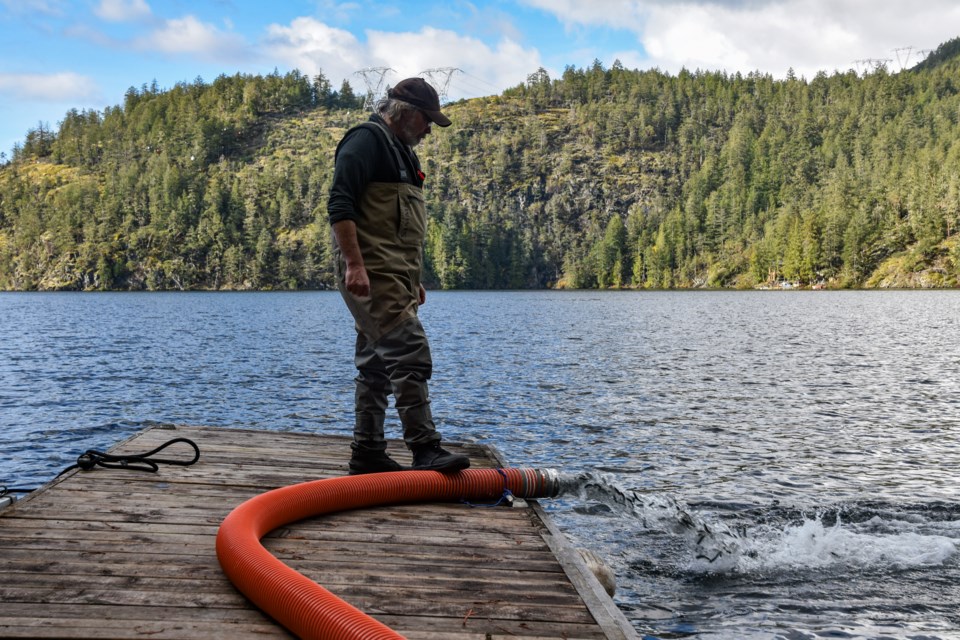While sockeye salmon are accustomed to making vast journeys and crossing seas, in late October more than 50,000 salmon got a first-hand glimpse of how humans get from Vancouver Island to the Sunshine Coast on their way to their new home.
On Oct. 29, 51,841 sockeye salmon were released into Sakinaw Lake as part of ongoing efforts to support wildlife populations.
According to Fisheries and Oceans Canada (DFO) between 1950 and 1980, an average of 5,000 adult Sakinaw sockeye returned to Sakinaw Lake each year to spawn, however, the population suffered a steep decline in the ‘80s and ‘90s due to low ocean survival and over-fishing.
From 2006 to 2009, no mating pairs were recorded returning to Sakinaw from the ocean.
Due to DFO’s captive brood program to support Sakinaw sockeye and efforts in partnership with shíshálh Nation, the population was saved from extinction. The program began in 2000 using brood stock from Sakinaw Lake and is based at DFO’s Rosewall Creek Hatchery on Vancouver Island.
A Gibsons resident and involved with DFO since 1994, Jim Wilson aquatic science technician at Fisheries and Oceans Canada has been heavily involved in recovering Sakinaw salmon populations.
Wilson said it's a good time of year to release salmon and noted last week’s group looked healthy.
Prefacing that whether you transport fish for 10 hours or 10 minutes you are bound to have some die-off, Wilson explained this method of releasing salmon is fairly gentle on the fish – of the more than 51,000 released, only a dozen didn’t survive the trip.
To ensure young juveniles are leaving Sakinaw each year, DFO transports 300,000 to 500,000 to the lake for release annually.
DFO also operates the Sakinaw Lake dam and monitors water levels on the lake –– which is historically prone to experiencing low water levels. DFO said due to drought and low snowpack levels in recent years, the water levels would not be sufficient to support salmon migration without human intervention.
Speaking to the vast distances salmon cover, Wilson said he’d tagged fish at Chapman Creek and found them two kilometres up Wilson Creek the next day.
He’s also seen marked Sakinaw sockeye turn up as far from home as Tzoonie and Theodosia Rivers.
Sockeye isn’t the only species of salmon native to Sakinaw and Wilson’s expertise in fish extends far beyond them as well. He recalled one time he saw a coho salmon jump 12 feet out of the water over the dam and into the lake.
He said this group of salmon would likely stay in the lake over the winter, then smolt and prepare themselves to go out to sea starting in mid-April and going until June.
A thousand of the fish released received a PIT tag, which Wilson explained is a small chip that acts like a barcode. When the fish leave the lake, an antenna scans the tags and registers how many fish have left, allowing DFO to create population models.
“And then, in theory, two years from now, when they've had two years at sea they’ll return and they will be scanned again when they come in, and we'll know how many of those fish out of that particular batch would survive that two years at sea,” Wilson said.
Some Sakinaw Lake locals assisted the release, whom Wilson called “really hardcore volunteers.”
Stephanie and Allan Belich who regularly lend their boat to DFO for releases, as well as Phil Ragan, came out to assist and are all well acquainted with Wilson.
You might expect the salmon to be eager to race out and explore their new environment after living in a tank. However, Stephanie explained that many fish raised in captivity stick near the release area for a while because they are looking for the container walls.
She said when they release salmon in the summer, they have up to 135,000 fish because they are much younger and smaller.
Once the salmon were in the lake, the team took a temperature reading of the water to see how close the temperature is to that of the tank.
Wilson mentioned the parental-based tagging program, where DNA samples are taken from hatchery fish to create a family profile. The process takes a long time, as many as three generations, but eventually, it will provide data on how many fish are native to a particular stream and give insight into how far along groups of salmon are on their journey.
He reiterated how instrumental local volunteers are to these releases, allowing DFO to use private property and other resources.
Wilson also said they would not be able to operate the captive brood program without the relationship with shíshálh Nation, saying some of their staff have been involved with the program for longer than he has.
DFO said shíshálh Nation staff monitor smolt outmigration numbers and water quality, compile catch data and monitor the number of fish that return to the lake to spawn using a motion-detecting camera and electronic tagging of fish.
All Sakinaw salmon today are descendants of DFO’s captive brood program.
“We had 180 fish return this year, which is really small in the grand scheme, but I also remember when it was zero,” Wilson said.
Jordan Copp is the Coast Reporter’s civic and Indigenous affairs reporter. This reporting beat is made possible by the Local Journalism Initiative.
Words missing in article? Your adblocker might be preventing hyperlinked text from appearing.



